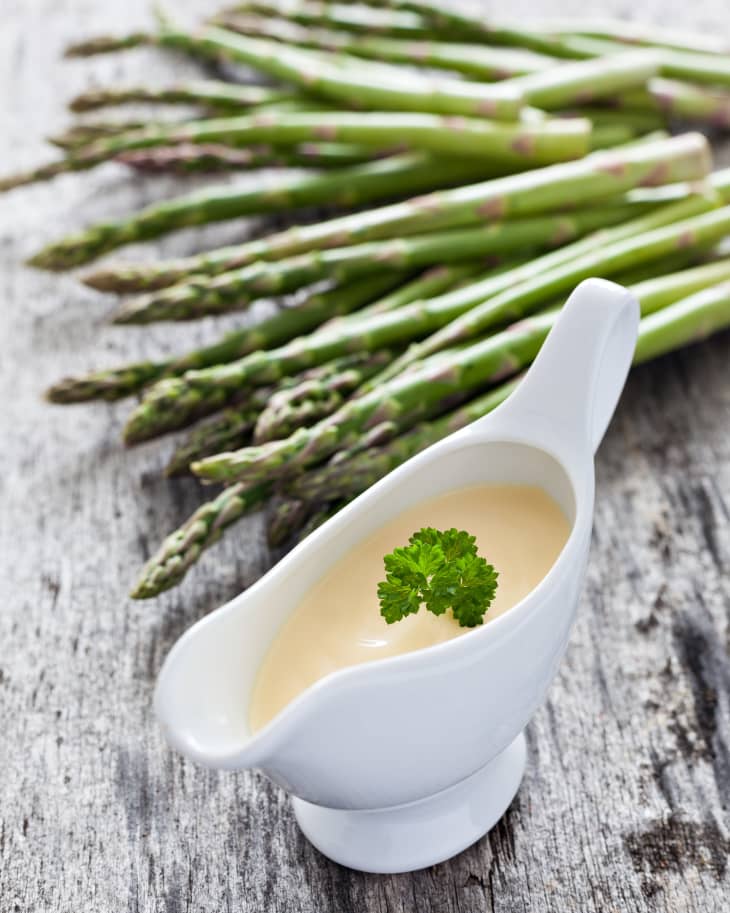Do You Know Your French Mother Sauces?
Going to culinary school in France meant that our main focus was, of course, French cuisine. And as I quickly learned, French cuisine is all about sauce. At the end of each day, we nervously brought our version of what had been demonstrated earlier to our chef for critique. It was usually a composed plate of protein and sides, but what did the chef always taste first? The sauce.
He’d swipe his fork and knife through the sauce, judging viscosity and eyeing color before tasting and passing judgment. No matter how perfectly cooked and executed the other components were, the sauce mattered the most.
What Is a Mother Sauce?
French chef Marie Antoine-Carême was the first to organize all the French sauces into groups that were based on four foundational sauces. Later, French chef Auguste Escoffier added one more sauce so that there were now five “mother sauces,” which he codified in recipe form in Le Guide Culinaire in 1903.
These sauces were seen as the foundations for many dishes and other sauces, and they were supposed to be known by heart by culinary students. While they are still taught in culinary schools and deemed foundational, some are used often in home cooking, while others are used more in restaurant cooking or rarely made at all anymore.
The Importance of Roux
Before we list the five sauces, we need to talk about roux. What makes a sauce a sauce? Basically, liquid needs to be thickened so that it coats and clings to food instead of running off of it. Thickening can happen by cooking down and reducing things like tomato sauce, which will naturally thicken as moisture evaporates, but other sauces need a little help.
This is where roux comes in. Roux is basically cooking fat and flour together before adding in the liquid you want thickened. The fat used is generally butter, but oil or other fats can also be used. The fat and flour cook together briefly to cook out some of the floury, pasty flavor in the flour (and in Southern cooking, roux is actually cooked until very dark to add a nutty, toasty flavor). When the liquid is added to roux and everything comes to a boil, the flour thickens the liquid and you end up with sauce.
Four out of the five mother sauces are thickened by roux, which is why it’s important that you know what it is.
The 5 French Mother Sauces
1. Béchamel
This is roux whisked with milk or other dairy to make a white sauce. Ever made macaroni and cheese or chicken pot pie? The base of both these dishes is béchamel. By itself, béchamel is quite bland, which is why it is usually cooked with other ingredients and not used as a finishing sauce.
- Get a recipe: How To Make a Béchamel Sauce (White Sauce)
2. Velouté
A velouté is a light roux whisked with chicken, turkey, fish or any other clear stock. The resulting sauce takes on the flavor of the stock, and the name is derived from the French word for velvet, which aptly describes this smooth but light and delicate sauce. It is usually served over fish or poultry that has been delicately cooked, like by poaching or steaming.
3. Espagnole
Sauce espagnole is a basic brown sauce. It’s made of brown beef or veal stock, tomato puree, and browned mirepoix, all thickened with a very dark brown roux. This sauce is sometimes used at the foundation for boeuf bourguinon and demi-glace.
4. Sauce Tomato
This is made by cooking tomatoes down into a thick sauce but used to also be thickened with roux. Unlike more modern-day tomato sauces, the classic French tomato sauce is flavored with pork and aromatic vegetables.
5. Hollandaise
This is the one mother sauce not thickened by a roux. Instead, it’s thickened by an emulsion of egg yolk and melted butter, which means it’s a stable mixture of two things that usually normally can’t blend together. This is a very delicate sauce because the emulsion can easily break, and rich hollandaise is usually used as a dipping sauce for asparagus or a finishing sauce for dishes like eggs Benedict.
- Get a recipe: How to Make Hollandaise Sauce
These five sauces pack tons of flavor and enhance whatever they’re served with. While some are used more than others nowadays, you’ve got to respect the versatility of them and how they can form the basis for countless other sauces and flavor combinations!
